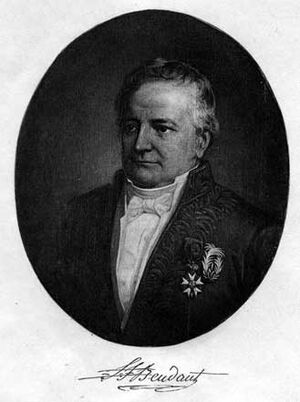François Sulpice Beudant facts for kids
François Sulpice Beudant (born September 5, 1787 – died December 10, 1850) was a famous French scientist. He was a mineralogist, which means he studied minerals, and a geologist, meaning he studied the Earth's rocks and history. A special mineral called beudantite was even named after him!
Contents
A Scientist's Life
François Sulpice Beudant was born in Paris, France. He was very smart and went to two important schools: the Ecole Polytechnique and the Ecole Normale.
Early Career and Discoveries
In 1811, Beudant became a professor of mathematics in Avignon. A few years later, in 1813, he moved to Marseilles to teach physics. While there, he did something amazing: he made the very first measurements of how fast sound travels in seawater!
The next year, he was trusted with a big job. He had to take the royal collection of minerals to England. This experience made him really interested in geology and other related sciences.
Exploring Minerals and Earth
In 1817, Beudant wrote about how minerals form crystals. He showed that the same mineral can take on many different shapes. This was a big step in understanding minerals.
In 1818, the French government sent him on an exciting trip to Hungary to study its geology. His detailed findings from this journey were published in a large book called Voyage minéralogique et géologique en Hongrie in 1822. This book made him famous across Europe.
Teaching and Naming Minerals
In 1820, Beudant became a professor of mineralogy at the University of Paris. He later became an inspector for the whole university system. He wrote many books about physics, mineralogy, and geology.
One of his most important books was the second edition of Traite Elementaire de Mineralogie, published between 1830 and 1832. In this book, he gave names to many minerals we still know today, like anglesite, bismuthite, and cerussite. It's a great honor that the mineral beudantite is named after him!
Images for kids



